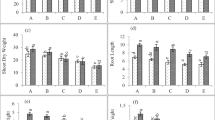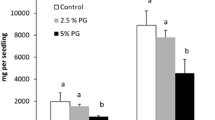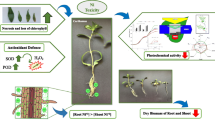Abstract
The aim of the present work was to study the response of two sunflower genotypes (cultivated sunflower Helianthus annuus cv. 1114 and newly developed genotype H. annuus × Helianthus argophyllus) to Pb medium-term stress and the role of exogenously applied EDTA in alleviating Pb toxicity in hydroponics. Plant growth, morpho-anatomical characteristics of the leaf tissues, electrolyte leakage, total antioxidant activity, free radical scavenging capacity, total flavonoid content, and superoxide dismutase isoenzyme profile were studied by conventional methods. Differential responses of both genotypes to Pb supplied in the nutrient solution were recorded. Pb treatment induced a decrease in the relative growth rate, disturbance of plasma membrane integrity, and changes in the morpho-anatomical characteristics of the leaf tissues and in the antioxidant capacity, which were more pronounced in the cultivated sunflower H. annuus cv. 1114. The new genotype demonstrated higher tolerance to Pb when compared with the cultivar. This was mainly due to increased photosynthetically active area, maintenance of plasma membrane integrity, permanently high total antioxidant activity, and free radical scavenging capacity as well as total flavonoid content. The addition of EDTA into the nutrient solution led to limitation of the negative impact of Pb ions on the above parameters in both genotypes. This could be related to the reduced content of Pb in the roots, stems, and leaves, suggesting that the presence of EDTA limited the uptake of Pb. The comparative analysis of the responses to Pb treatment showed that the deleterious effect of Pb was more pronounced in the cultivated sunflower H. annuus cv. 1114. The new genotype H. annuus × H. argophyllus was more productive and demonstrated higher tolerance to Pb medium-term stress, which could indicate that it may possess certain mechanisms to tolerate high Pb concentrations. This character could be inherited from the wild parent used in the interspecific hybridization. The ability of EDTA to prevent Pb absorption by the plants could underly the mechanism of limiting of the negative impact of Pb ions. Hence, EDTA cannot be used to enhance Pb absorption from nutrient solution by sunflower plants for phytoremediation purposes.






Similar content being viewed by others
References
Alsche RG, Erturk N, Heath LS (2002) Role of superoxide dismutases (SODs) in controlling oxidative stress in plants. J Exp Bot 53:1331–1341
Benzie IFF, Strain JJ (1999) Ferric reducing/antioxidant power assay: direct measure of total antioxidant activity in biological fluids and modified version for simultaneous measurement of total antioxidant power and ascorbic acid concentration. Method Enzymol 299:15–27
Blaylock MJ, Salt DE, Dushenkov S, Zakharova O, Gussman C, Kapulnik Y, Ensley BD, Raskin I (1997) Enhanced accumulation of Pb in Indian mustard by soil-applied chelating agents. Environ Sci Technol 31:860–865
Brand-Williams W, Cuvelier ME, Berset C (1995) Use of a free radical method to evaluate antioxidant activity. Lebensm Wiss Technol 28:25–30
Bridges SM, Salin ML (1981) Distribution of iron-containing superoxide dismutases in vascular plants. Plant Physiol 68:275–278
Collado MB, Arturi MJ, Aulicino MB, Molina MC (2010) Identification of salt tolerance in seedling of maize (Zea mays L.) with the cell membrane stability trait. Int Res J Plant Sci 1:126–132
Davis BJ (1964) Disk electrophoresis. Method and application to human serum protein. Ann NY Acad Sci 121:404–427
De la Rosa G, Peralta-Videa JR, Crus-Jimenez G, Duarte-Gardea M, Martinez-Martinez A, Cano-Aguilera I, Sharma NC, Sahi SV, Gardea-Torresdey JL (2007) Role of ethylenediaminetetra acetic acid on lead uptake and translocation by tumbleweed (Salsola kali L.). Environ Toxicol Chem 26:1033–1039
Dominguez-Solis JR, Lopez-Martin MC, Ager FJ, Ynsa MD, Romero LC, Gotor C (2004) Increased cysteine availability is essential for cadmium tolerance and accumulation in Arabidopsis thaliana. Plant Biotechnol J 2:469–476
Doncheva S, Poschenrieder C, Stoyanova Z, Georgieva K, Velichkova M, Barceló J (2009) Silicon ameliorates manganese toxicity in Mn-sensitive maize, but is not responsible for tolerance in a Mn-tolerant maize genotype. Environ Exp Bot 65:189–197
EPA (2005) Lead in paint, dust, and soil. US Environmental Protection Agency. http://www.epa.gov/lead/
Fambrini M, Sebastiani L, Rossi VD, Cavallini A, Pugliesi C (1997) Genetic analysis of an electrophoretic variant for the chloroplast-associated form of Cu/Zn superoxide dismutase in sunflower (Helianthus annuus L.). J Exp Bot 48:1143–1146
Fernandez-Ocana A, Chaki M, Luque F, Gómez-Rodríguez M, Carreras A, Valderrama R, Begara-Morales JC, Hernández F, Corpas J, Barroso J (2011) Functional analysis of superoxide dismutases (SODs) in sunflower under biotic and abiotic stress conditions. Identification of two new genes of mitochondrial Mn-SOD. J Plant Physiol 168:1303–1308
Fotopoulos V, De Tullio MC, Barnes J, Kanellis AK (2008) Altered stomatal dynamics in ascorbate oxidase over-expressing tobacco plants suggest a role for dehydroascorbate signalling. J Exp Bot 59:729–737
Garnier E, Salager JL, Laurent G, Sonié L (1999) Relationships between photosynthesis, nitrogen and leaf structure in 14 grass species and their dependence on the basis of expression. New Phytol 143:119–129
Geebelen W, Vangronsveld J, Adriano DC, Van Poucke LC, Clijsters H (2002) Effect of Pb–EDTA and EDTA on oxidative stress reactions and mineral uptake in Phaseolus vulgaris. Physiol Plant 115:377–384
Gostin I, Ivanescu L (2007) Structural and micromorphological changes in leaves of Salix alba under air pollution effect. Int J Energy Environ 1:219–226
Gutiérrez-Alcalá G, Gotor C, Meyer AJ, Fricker M, Vega JM, Romero LC (2000) Glutathione biosynthesis in Arabidopsis trichome cells. Proc Natl Acad Sci USA 97:11108–11113
Harris H, Hopkinson DA (1976) Handbook of enzyme electrophoresis in human genetics. North-Holland, Amsterdam
Hepler PK (2005) Calcium: a central regulator of plant growth and development. Plant Cell 17:2142–2155
Hernández-Allica J, Garbisu C, Barrutia O, Becerril JM (2007) EDTA-induced heavy metal accumulation and phytoxicity in cardoon plants. Environ Exp Bot 60:26–32
Hetherington AM, Woodward FI (2003) The role of stomata in sensing and driving environmental change. Nature 424:901–908
Hirschi KD (2004) The calcium conundrum. Both versatile nutrient and specific signal. Plant Physiol 136:2438–2442
Huang H, Li T, Tian S, Gupta DK, Zhang X, Yang X (2008) Role of EDTA in alleviating lead toxicity in accumulator species of Sedum alfredii H. Bioresource Technol 99:6088–6096
Jamal A, Yoo NH, Yun SJ (2007) Isoform-specific responses of superoxide dismutase to oxidative stresses and hormones in parquat-tolerant Rehmannia glutinosa. J Crop Sci Biotech 10:10–14
Jiang W, Liu D (2010) Pb-induced cellular defence system in the root meristematic cells of Allium sativum L. BMC Plant Biol 10:40
Kim C, Lee Y, Ong SK (2003) Factors affecting EDTA extraction of lead from lead-contaminated soils. Chemosphere 51:845–853
Komárek M, Tlustoš P, Száková J, Chrastný V, Ettler V (2007) The use of maize and poplar in chelant-enhanced phytoextraction of lead from contaminated agricultural soils. Chemosphere 67:640–651
Krystofova O, Shestivska V, Galiova M, Novotny K, Kaiser J, Zehnalek J, Babula P, Opatrilova R, Adam V, Kizek R (2009) Sunflower plants as bioindicators of environmental pollution with lead (II) ions. Sensors 9:5040–5058
Lamaison JLC, Carnet A (1990) Teneur en principaux flavonoid des fleurs de Crataegeus monogyna Jacq et de Crataegeus-laevigata (Poiret D.C.) en fonction de la vegetation. Pharm Acta Helv 65:315–320
Liu D, Li T, Yang X, Islam E, Jin X, Mahmood Q (2007) Enhancement of lead uptake by hyperaccumulator plant species Sedum Alfredii hance using EDTA and IAA. Bull Environ Contam Toxicol 78:280–283
Liu D, Zou J, Meng Q, Zou J, Jiang W (2009) Uptake and accumulation and oxidative stress in garlic (Allium sativum L.) under lead phytotoxicity. Ecotoxicology 18:134–143
Manousaki E, Kalogerakis N (2009) Phytoextraction of Pb and Cd by the Mediterranean saltbush (Atriplex halimus L.): metal uptake in relation to salinity. Environ Sci Polut Res 16:844–854
Marschner H (1995) Mineral nutrition of higher plants. Academic, London, p 889
Martell AE, Smith RM, Motekaitis RJ (2001) NIST. Critically selected stability constants of metal complexes. Version 6.0 NIST Gaithersburg
McBride MB (1994) Environmental chemistry of soils. Oxford University Press, Oxford
Roy R, Agrawal V, Gupta SC (2009) Comparison of drought-induced polypeptides and ion leakage in three tomato cultivars. Biol Plantarum 53:685–690
Ruley A, Sharma NC, Sahi SV, Singh SR, Sajwan KS (2006) Effects of lead and chelators on growth, photosynthetic activity and Pb uptake in Sesbania drummondii grown in soil. Environ Pollut 144:11–18
Saifullah R, Meers E, Qadir MP, de Caritat F, Tack FMG, Du Laing G, Zia MH (2009) EDTA-assisted Pb phytoextraction. Chemoshere 74:1279–1291
Sarret G, Vangronsveld J, Manceau A, Musso M, D’Haen J, Menthonnex JJ, Hazemann JL (2001) Accumulation forms of Zn and Pb in Phaseolus vulgaris in the presence and absence of EDTA. Environ Sci Technol 35:2854–2859
Shu X, Yin LY, Zhang QF, Wang WB (2012) Effect of Pb toxicity on leaf growth, antioxidant enzyme activities, and photosynthesis in cutting and seedlings of Jatropha curcas L. Environ Sci Polut Res 19:893–902. doi:10.1007/s11356-011-0625-y
Sinegani AA, Khalilikhah SF (2008) Phytoextraction of lead by Helianthus annuus: effect of mobilising agent application time. Plant Soil Environ 54:434–440
Tian S, Lu L, Yang X, Huang H, Brown P, Labavitch J, Liao H, He Z (2011) The impact of EDTA on lead distribution and speciation in the accumulator Sedum alfredii by synchrotron X-ray investigation. Environ Pollut 159:782–788
Vassil AD, Kapulnik Y, Raskin I, Salt DE (1998) The role of EDTA in lead transport and accumulation by Indian Mustard. Plant Physiol 117:447–453
Vassilevska-Ivanova R, Tcekova Z (2005) Agronomic characteristic of a dwarf germplasm sunflower line. Helia 28:51–56
Weryszko-Chmielewska E, Chwil M (2005) Lead-induced histological and ultrastructural changes in the leaves of Soybean (Glycine max L. Merr.). Soil Sci Plant Nutr 51:203–212
Xu J, Zhang YX, Wei W, Han L, Guan ZQ, Wang Z, Chai TY (2008) BjDHNs confer heavy-metal tolerance in plants. Mol Biotechnol 38:91–98
Yamori W, Noguchi K, Terashima I (2005) Temperature acclimation of photosynthesis in spinach leaves: analyses of photosynthetic components and temperature dependencies of photosynthetic partial reactions. Plant Cell Environ 28:536–547
Acknowledgments
This work was supported by a bilateral project between the Institute of Plant Physiology and Genetics, BAS, and the Department of Botany, Aristotle University of Thessaloniki.
Author information
Authors and Affiliations
Corresponding author
Additional information
Responsible editor: Elena Maestri
Rights and permissions
About this article
Cite this article
Doncheva, S., Moustakas, M., Ananieva, K. et al. Plant response to lead in the presence or absence EDTA in two sunflower genotypes (cultivated H. annuus cv. 1114 and interspecific line H. annuus × H. argophyllus). Environ Sci Pollut Res 20, 823–833 (2013). https://doi.org/10.1007/s11356-012-1274-5
Received:
Accepted:
Published:
Issue Date:
DOI: https://doi.org/10.1007/s11356-012-1274-5




